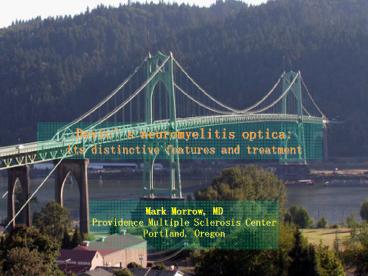Devic - PowerPoint PPT Presentation
Title:
Devic
Description:
Devic s neuromyelitis optica: its distinctive features and treatment Mark Morrow, MD Providence Multiple Sclerosis Center Portland, Oregon Conclusions Neuromyelitis ... – PowerPoint PPT presentation
Number of Views:73
Avg rating:3.0/5.0
Title: Devic
1
Devics neuromyelitis optica its distinctive
features and treatment
- Mark Morrow, MD
- Providence Multiple Sclerosis Center
- Portland, Oregon
2
Conclusions
- Neuromyelitis optica is a distinct demyelinating
disease with accurate diagnostic criteria - Demographic and historic features predict
relapses - Relapse prevention requires broad-spectrum or
B-cell-specific immunosuppression
3
Age 4 Severe visual loss OU and generalized
burning sensation Age 7 Quadriparesis and
progression to no light perception OU Age 28-33
Progressive weakness, neuropathic pain Exam no
light perception, sheet-white optic atrophy OU
severe spastic quadriparesis
4
NMO-IgG antibody gt160,000
5
Neuromyelitis optica (NMO)
- Acute/subacute demyelination, necrosis of optic
nerves, spinal cord - Often preceded by viral illness, associated with
systemic autoimmune disease - Significant residua common
- Partial responses to steroids, other
immunosuppressants
6
Key clinical features
- Optic neuritis
- Acute/subacute neuropathic visual loss
- Typically painful
- Mild, if any, disc edema
- Myelitis
- Acute/subacute weakness, numbness
- Bowel/bladder problems
- Lhermittes sign
7
The broadening spectrum of NMO
- Textbook form
- Monophasic
- Simultaneous ON and SC disease
- Bilateral ON involvement
- No disease outside SC, ONs
- No brain MRI lesions
- Current description
- gt70 recurrent
- ON and SC attacks may be years apart
- ON disease may be unilateral
- Brain disease occurs (ca. 10)
- Brain MRI changes may occasionally resemble
multiple sclerosis
ON optic nerve SC spinal cord
8
NMO disease or syndrome?
- Differential diagnosis
- Multiple sclerosis
- Acute disseminated encephalomyelitis (ADEM)
- Lupus
- Sjogrens syndrome
- Parainfectious
9
How does NMO compare with MS?
- Similarities
- Female predilection
- Age of onset
- Relapse rate
- Differences
- Geography
- Brain symptoms
- Prognosis
- MRI appearance
- Cerebrospinal fluid findings
- Response to treatment
10
Ancillary tests in NMO
- MRI
- Elongated, expansile, enhancing spinal cord
lesions - Brain MRI usually normal occasional
multiple-sclerosis-like plaques or
confluent/symmetrical lesions - CSF
- gt50 white blood cells/mm3 or gt5
polymorphonuclear leucocytes/mm3 common - Oligoclonal bands, ?IgG synthesis less common
11
The NMO antibody
- IgG autoantibody localizes to glia at
blood-brain-barrier - Binds to aquaporin-4, the main water channel in
the central nervous system - About 90 specific, 75 sensitive for NMO
- Often in brain MRI- negative relapsing
myelitis/optic neuritis - Available commercially
12
The epidemiology of MS and NMO differs in Japan
and the West
- Lower prevalence of MS in Japan
- Higher ratio of classic, monophasic NMO to MS,
likely true throughout Asia - More Japanese MS patients present with
bilateral optic neuropathy and severe ON or SC
disease (ca. 25) - Up to 60 of Asian optospinal MS may be for
NMO-IgG, implying that this condition represents
recurrent NMO
13
Laotian woman Age 47-52 4 bouts unilateral optic
neuritis Age 54 transverse myelitis Exam no
light perception OD, 20/20 OS, spastic
paraparesis NMO-IgG positive
14
NMO the latest criteria
- History of optic neuritis
- History of acute myelitis
- Two of three of
- MRI spinal cord lesion gt 3 segments
- NMO-IgG antibody
- Brain MRI not consistent with multiple
sclerosis
Wingerchuk et al. Revised diagnostic criteria for
NMO. Neurology 2006661485-9 (99 sensitive,
90 specific)
15
Who will relapse?
- Older patients with more common, sequential optic
neuritis/myelopathic disease - Less severe disease at onset
- High-titer NMO-IgG antibodies
- Step-wise progression portends worse prognosis
than monophasic disease
16
45 year old man 1.5 yrs ago subacute myelopathy
preceded by flu-like illness Since then several
mild myelopathic relapses, occasional blurring
Exams spastic paraparesis, normal optic nerves
and vision Normal CSF, - NMO-IgG
17
Treatment for NMO
- Relapses/acute disease
- IV methylprednisolone 1000 mg/day, 3-5 days
- Plasmapheresis
- Prevention / stabilization
- Consensus ABCR drugs not helpful
- Azathioprine 2.5-3 mg/kg/day
- Concurrent prednisone 1 mg/kg/day, tapering
slowly after azathioprine takes effect - Mycophenolate mofetil, Mitoxantrone, Rituximab,
IVIg, Plasmapheresis possible second liners
No class I or II data
18
From Ransohoff R. J Clin Invest. 2006 September
1 116(9) 23132316.































